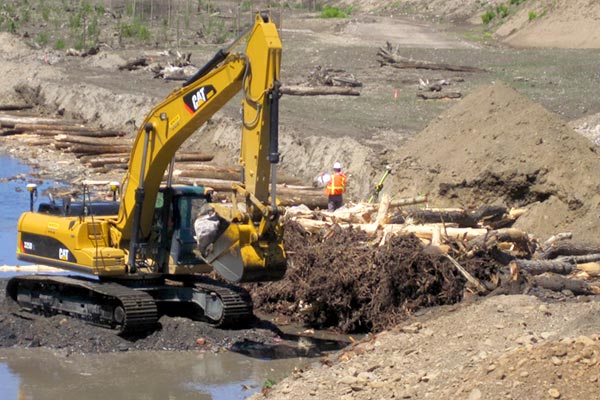 Site Overview
Site Overview
The Clark Fork and Blackfoot Rivers converged into the common Milltown Reservoir created by the historic Milltown Dam. A massive flood washed mine waste into the Clark Fork River, and ultimately to the Milltown Dam. Envirocon removed the dam and spillway structures, and excavated and disposed of trapped sediments by rerouting the Clark Fork River into a constructed bypass channel. Envirocon installed new stream banks, temporary diversion dikes, and grade control bed structures using best management practices for erosion and stormwater protection including boulders, cobble, and riprap. We created new bank stabilization structures using log and wood debris, vegetated soil lifts, and sod brush trenches. The design included construction of pools, riffles, runs, and glides to optimize fish habitat. After the grading work, our team roughened the floodplain and placed woody debris to promote trapping of sediment and seed with overhangs in debris structures designed to maximize habitat. The Blackfoot and Clark Fork Rivers flowed freely for this first time in 100 years at the end of the project.
Project Highlights
- Constructed the final Clark Fork River alignment, restored habitat, and re-routed the river to its permanent location
- Completed work in challenging and changing river conditions
- Demolished and removed the historic Milltown Dam powerhouse and spillway structures
- Utilized several field crews simultaneously, managing up to 70 personnel during the remedial actions at two locations over 100 miles apart
- Received the Environmental Business Journal Business Achievement Award, Project Merit Award for Remediation and Restoration in 2007
Value Delivered
Multiple project regulators and stakeholders (i.e., EPA, MDEQ, and MT Dept. of Fish, Wildlife, and Parks) required that Envirocon meet surface water quality standards in the river during fish spawning. We determined the precise timing to safely breach the dams/cofferdams and optimized equipment and personnel use with a resource-loaded schedule to perform work around the “fish windows” without affecting the overall schedule.